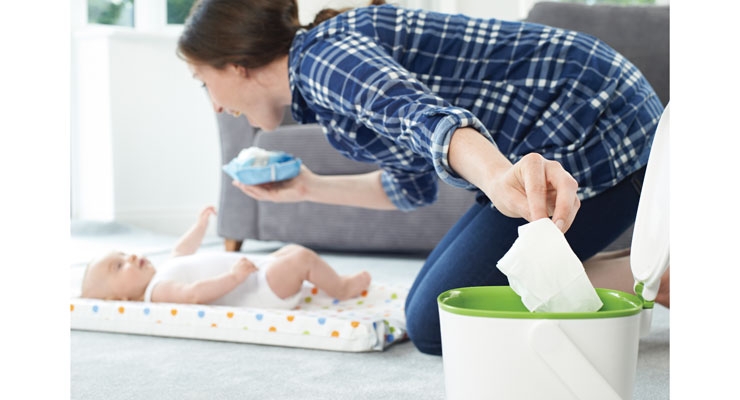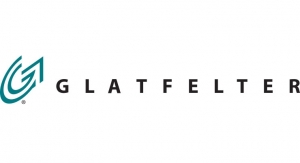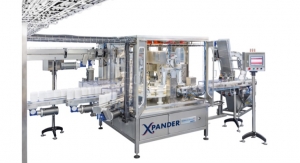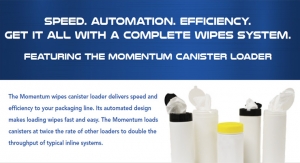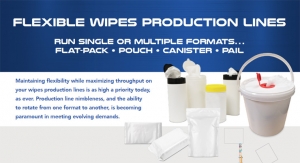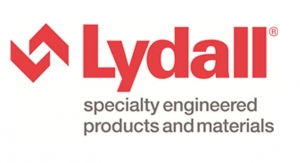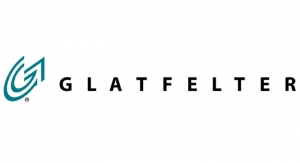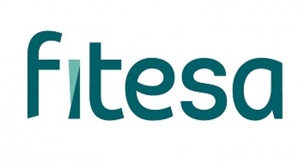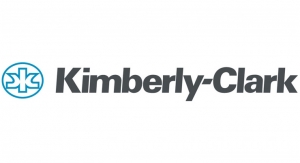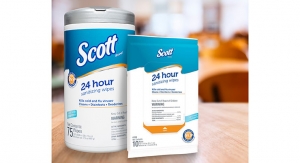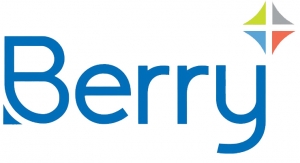Joy Steed, Smithers Pira04.12.18
By Joy Steed
Smithers Pira
Wipes will continue to present a compelling market opportunity for nonwovens across the next five years as a combination of market and technology factors boost overall value and use globally. This promising market evolution is tracked in detail in the recent market study The Future of Global Nonwoven Wipes to 2023 from Smithers Pira. This study tracks how the volume of nonwovens converted into wipes for consumer and industrial applications will rise 6.3% per year from 1.20 million tons in 2018 to 1.63 million tons in 2023.
This is also an increasingly lucrative segment. Its global value passed the $2 billion mark for the first time in 2017 and will reach $2.84 billion in 2023.
Commercially this is a diversified market. Procter & Gamble (P&G) is the largest global supplier but accounts for only 14.5% of worldwide value. The next four largest firms hold around 20% of the market, combined, meaning there remain multiple opportunities for smaller and locally based companies.
There are multiple supply and demand side influences on and within worldwide consumption for wipes—Smithers’ analysis identifies the following four as among those whose impact will be most pronounced across its forecast period.
Over and Under-Supply
Of the different nonwovens technologies, spunlace continues to be the largest and fastest-growing process used to make wipes base sheet. Airlaid is still the second largest, but there continue to be significant changes in the composition and growth for both of these and other nonwoven types in wipes.
Within spunlace, booming demand for flushable consumer wipes is fuelling rapid expansion in global capacities for dispersible hydroentangled wetlaid stock.
A total of 11 new hydroentangled wetlaid spunlace lines have been added globally since 2015, adding about 115,000 tons of new capacity. Germany’s Voith-Truetzschler and Austria-headquartered Andritz have supplied the majority of the machinery for these new lines. This expansion could pose a problem for the future as a major over-supply of hydroentangled wetlaid materials is predicted before the end of the decade, and firms will need to optimize processes or develop new markets to maximize returns from these investments.
A contrasting problem confronts the airlaid segment. A series of line closures in the past decade from companies such as Georgia-Pacific, combined with failures of new lines like Fiberweb’s Italian installation have squeezed capacity. A long-term lack of investment in this segment is now being addressed by Glatfelter, which will add 20,000 tons to annual output with its new line at Fort Smith, AR.
Home and Personal Care Wipes
The consumer wipes segment includes baby, personal care and home care wipes. Baby wipes is the dominant segment accounting for 73.7% of total value in consumer wipes in 2018; but it is also the most mature and will lose relative marketshare to wipes for personal care and use in the home across the next five years.
This does not necessarily represent a shift in usage however. Some of this change is attributable to a substitution towards new dedicated personal care wipes – like adult moist toilet tissue or toddler toilet care wipes, where consumers previously made use of baby wipes for these applications. This trend is especially prevalent in emerging market regions that have previously not been able to sustain demand for these more specialized products.
Personal care wipes are benefitting from the increased capacity for formulated flushable wipes. Smithers’ analysis shows that adult moist toilet tissue and toddler toilet care wipes will grow most quickly across 2018-2023; although as discretionary items, these do suffer drops in sales in times of economic hardship in certain markets.
This segment has had to react to government and lobby groups criticizing the market preference for flushable wipes, blaming limited dispersibility for blocking sewage pipes. The joint action of industry bodies INDA and EDANA in formulating guidelines on flushability and widespread adherence to them has helped blunt this threat.
The fundamental drivers for home care wipes remain convenience and timesaving. Although some sub-segments – like electrostatic dusting wipes – have become the default choice for a specific task, others, like bathroom cleaning wipes, can easily be replaced by liquid cleaners and paper towels.
Cleaning/disinfectant wipes is one of the three largest sub-segments for home care wipes and the one with the greatest potential across 2018-2023. Now worth over $1.5 billion these products are considered more necessary by consumers and benefit from a general concern about germs in the household and can be boosted by outbreak of infectious diseases like the avian and swine flu strains, Ebola virus, Zika and noroviruses. It is the only market segment growing at a significantly above-average rate within home care wipes.
Industrial Applications
Industrial wipes or institutional wipes are products sold business-to-business, although some applications are similar to those served by consumer wipes. In 2018, industrial wipes are worth $3.38 million just over 20% of the total global wipes value, and they will marginally increase this market share through 2018.
Within this category, food service wipes will be the fastest growing. New demands from end-users is seeing new formats optimized for longevity in use; with either more effective built-in antimicrobials or more inertness towards typical antimicrobial solutions.
This is because cationic antimicrobials commonly react with standard nonwovens; making a wipe designed to be as close to totally inert as possible towards antimicrobials is an advantage. Several suppliers have introduced “quaternary ammonium compound” inert wipes.
Looking South and East
Market demand for wipes has and will continue to be affected by both long-term economic global and national trends. The broader narrative is that wipes of all formats will see the greatest growth outside its historical core markets in North America and Western Europe—although these will still command nearly two thirds of world value through to 2023.
Asia is the third largest regional market by market worth nearly $2.8 billion in 2018 and will exceed $4 billion in 2023. Significantly home care wipes will overtake baby wipes as the most lucrative segment for the first time in 2018, led by electrostatic wipes, followed by cleaning/disinfectant formats.
China accounts for about 61.6% of the nonwoven wipes sales in Asia in 2018 – 10.4% of global nonwoven wipes sales in 2018, and by 2023 it will overtake the U.K. to be the second largest national market worldwide. Increased local production of nonwovens for wipes will be somewhat offset by lower overall economic growth, however it is forecast that a reduction in the cost of wipes will allow wipes to keep a “luxury” consumer image and witness only a moderate drop in overall growth.
The highest rate of expansion across the next five years are in South and Central America and Eastern Europe. Despite a slowdown due to economic problems in Venezuela and Brazil, double digit growth is predicted for value and volume in South and Central America across 2018-2023 for all wipe types, except baby wipes. This will make it the fastest growing region by value for the Smithers forecast period.
Eastern Europe will also see strong expansion across 2018-2023, although tonnage consumption will significantly exceed value increases for this period. Worth less than $1 billion in 2018; this value will none the less climb to fractionally more than $1.6 billion in 2023 – due mainly to its three largest national consumers Turkey, Russia and Poland.
The impact of these and other key trends for the nonwoven wipes sector are critically analyzed and quantified in the Smithers Pira report The Future of Global Nonwoven Wipes to 2023: www.smitherspira.com/industry-market-reports/nonwovens/global-nonwoven-wipes-to-2023.
Smithers Pira
Wipes will continue to present a compelling market opportunity for nonwovens across the next five years as a combination of market and technology factors boost overall value and use globally. This promising market evolution is tracked in detail in the recent market study The Future of Global Nonwoven Wipes to 2023 from Smithers Pira. This study tracks how the volume of nonwovens converted into wipes for consumer and industrial applications will rise 6.3% per year from 1.20 million tons in 2018 to 1.63 million tons in 2023.
This is also an increasingly lucrative segment. Its global value passed the $2 billion mark for the first time in 2017 and will reach $2.84 billion in 2023.
Commercially this is a diversified market. Procter & Gamble (P&G) is the largest global supplier but accounts for only 14.5% of worldwide value. The next four largest firms hold around 20% of the market, combined, meaning there remain multiple opportunities for smaller and locally based companies.
There are multiple supply and demand side influences on and within worldwide consumption for wipes—Smithers’ analysis identifies the following four as among those whose impact will be most pronounced across its forecast period.
Over and Under-Supply
Of the different nonwovens technologies, spunlace continues to be the largest and fastest-growing process used to make wipes base sheet. Airlaid is still the second largest, but there continue to be significant changes in the composition and growth for both of these and other nonwoven types in wipes.
Within spunlace, booming demand for flushable consumer wipes is fuelling rapid expansion in global capacities for dispersible hydroentangled wetlaid stock.
A total of 11 new hydroentangled wetlaid spunlace lines have been added globally since 2015, adding about 115,000 tons of new capacity. Germany’s Voith-Truetzschler and Austria-headquartered Andritz have supplied the majority of the machinery for these new lines. This expansion could pose a problem for the future as a major over-supply of hydroentangled wetlaid materials is predicted before the end of the decade, and firms will need to optimize processes or develop new markets to maximize returns from these investments.
A contrasting problem confronts the airlaid segment. A series of line closures in the past decade from companies such as Georgia-Pacific, combined with failures of new lines like Fiberweb’s Italian installation have squeezed capacity. A long-term lack of investment in this segment is now being addressed by Glatfelter, which will add 20,000 tons to annual output with its new line at Fort Smith, AR.
Home and Personal Care Wipes
The consumer wipes segment includes baby, personal care and home care wipes. Baby wipes is the dominant segment accounting for 73.7% of total value in consumer wipes in 2018; but it is also the most mature and will lose relative marketshare to wipes for personal care and use in the home across the next five years.
This does not necessarily represent a shift in usage however. Some of this change is attributable to a substitution towards new dedicated personal care wipes – like adult moist toilet tissue or toddler toilet care wipes, where consumers previously made use of baby wipes for these applications. This trend is especially prevalent in emerging market regions that have previously not been able to sustain demand for these more specialized products.
Personal care wipes are benefitting from the increased capacity for formulated flushable wipes. Smithers’ analysis shows that adult moist toilet tissue and toddler toilet care wipes will grow most quickly across 2018-2023; although as discretionary items, these do suffer drops in sales in times of economic hardship in certain markets.
This segment has had to react to government and lobby groups criticizing the market preference for flushable wipes, blaming limited dispersibility for blocking sewage pipes. The joint action of industry bodies INDA and EDANA in formulating guidelines on flushability and widespread adherence to them has helped blunt this threat.
The fundamental drivers for home care wipes remain convenience and timesaving. Although some sub-segments – like electrostatic dusting wipes – have become the default choice for a specific task, others, like bathroom cleaning wipes, can easily be replaced by liquid cleaners and paper towels.
Cleaning/disinfectant wipes is one of the three largest sub-segments for home care wipes and the one with the greatest potential across 2018-2023. Now worth over $1.5 billion these products are considered more necessary by consumers and benefit from a general concern about germs in the household and can be boosted by outbreak of infectious diseases like the avian and swine flu strains, Ebola virus, Zika and noroviruses. It is the only market segment growing at a significantly above-average rate within home care wipes.
Industrial Applications
Industrial wipes or institutional wipes are products sold business-to-business, although some applications are similar to those served by consumer wipes. In 2018, industrial wipes are worth $3.38 million just over 20% of the total global wipes value, and they will marginally increase this market share through 2018.
Within this category, food service wipes will be the fastest growing. New demands from end-users is seeing new formats optimized for longevity in use; with either more effective built-in antimicrobials or more inertness towards typical antimicrobial solutions.
This is because cationic antimicrobials commonly react with standard nonwovens; making a wipe designed to be as close to totally inert as possible towards antimicrobials is an advantage. Several suppliers have introduced “quaternary ammonium compound” inert wipes.
Looking South and East
Market demand for wipes has and will continue to be affected by both long-term economic global and national trends. The broader narrative is that wipes of all formats will see the greatest growth outside its historical core markets in North America and Western Europe—although these will still command nearly two thirds of world value through to 2023.
Asia is the third largest regional market by market worth nearly $2.8 billion in 2018 and will exceed $4 billion in 2023. Significantly home care wipes will overtake baby wipes as the most lucrative segment for the first time in 2018, led by electrostatic wipes, followed by cleaning/disinfectant formats.
China accounts for about 61.6% of the nonwoven wipes sales in Asia in 2018 – 10.4% of global nonwoven wipes sales in 2018, and by 2023 it will overtake the U.K. to be the second largest national market worldwide. Increased local production of nonwovens for wipes will be somewhat offset by lower overall economic growth, however it is forecast that a reduction in the cost of wipes will allow wipes to keep a “luxury” consumer image and witness only a moderate drop in overall growth.
The highest rate of expansion across the next five years are in South and Central America and Eastern Europe. Despite a slowdown due to economic problems in Venezuela and Brazil, double digit growth is predicted for value and volume in South and Central America across 2018-2023 for all wipe types, except baby wipes. This will make it the fastest growing region by value for the Smithers forecast period.
Eastern Europe will also see strong expansion across 2018-2023, although tonnage consumption will significantly exceed value increases for this period. Worth less than $1 billion in 2018; this value will none the less climb to fractionally more than $1.6 billion in 2023 – due mainly to its three largest national consumers Turkey, Russia and Poland.
The impact of these and other key trends for the nonwoven wipes sector are critically analyzed and quantified in the Smithers Pira report The Future of Global Nonwoven Wipes to 2023: www.smitherspira.com/industry-market-reports/nonwovens/global-nonwoven-wipes-to-2023.

